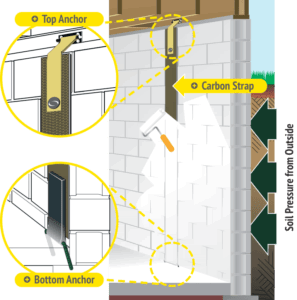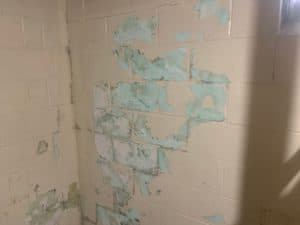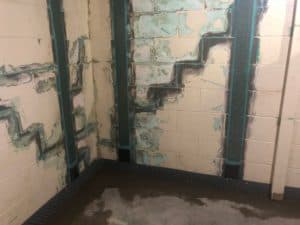
[et_pb_section fb_built="1" admin_label="section" _builder_version="4.16" global_colors_info="{}"][et_pb_row admin_label="row" _builder_version="4.16" background_size="initial" background_position="top_left" background_repeat="repeat" global_colors_info="{}"][et_pb_column type="4_4" _builder_version="4.16" custom_padding="|||" global_colors_info="{}" custom_padding__hover="|||"][et_pb_text admin_label="Text" _builder_version="4.27.4" background_size="initial" background_position="top_left" background_repeat="repeat" hover_enabled="0" global_colors_info="{}" sticky_enabled="0"]
It could be that you’ve found cracks in your basement wall and need carbon fiber straps for foundation repair to secure and stabilize your foundation. Maybe you read our blog on DIY Home Inspection, surveyed your home, and now have concerns. Perhaps a friend or neighbor suggested you contact us, or you’ve used our free diagnostic tool to check your symptoms.
Whatever virtual road you have taken, your search has clearly been driven by a need to learn more about carbon fiber foundation repair products. (And sorry! That pun was NOT intentional.)
Acculevel has been repairing foundations and restoring homeowners’ peace of mind since our beginning in 1996. We have installed straps in thousands of homes, and we proudly warranty our work for the life of the structure.
We’re going to explain what carbon straps are, why you need them, how they work, and what carbon fiber straps cost. This will help you understand what is involved in this type of repair, and how to choose the right contractor for your home.
Carbon fiber straps are a product commonly used in foundation repair to reinforce and stabilize a foundation wall.
Many companies try to use straps of solid carbon fiber or carbon fiber fabric as their strap material. These materials are very smooth, which prevents them from effectively adhering to any surface, including bowed walls, compromising foundation wall stabilization.
Think of it like trying to glue a smooth piece of plastic to another surface. The glue struggles to “grip” the smooth surface. And no matter how much glue you use, or how long you let the glue dry, it doesn’t take much effort to pull that plastic loose again.
In order to make the strap a cohesive part of the foundation, you need an unbreakable connection between carbon, epoxy and concrete.
In carbon fiber foundation repair, the key to success is creating an unbreakable connection between carbon, epoxy, and concrete. High-quality materials like kevlar-grade carbon fiber allow for a stronger bond and better structural reinforcement, ensuring lasting stability for your foundation.
 This is a close-up of a carbon fiber strap (picture taken by author).
This is a close-up of a carbon fiber strap (picture taken by author).
The strap we use is made of kevlar-grade carbon by Fortress Stabilization Systems. The “unidirectional method Fortress has developed creates a product twice as strong as products using woven carbon fibers."
This formulation creates small spaces in the carbon fiber straps (called open grid technology), and these spaces allow the epoxy to fully penetrate through the strap to the wall. Once the epoxy is smoothed on the surface, the strap’s epoxy rivet technology locks it onto the wall in thousands of spots, ensuring lasting structural reinforcement and foundation wall stabilization.
These straps are the strongest available and they are the only strapping product Acculevel uses. When we work on your home, we treat it as if it were our own; for us, that means using the best materials available.
 Illustration of an installed carbon fiber strap. The top and bottom anchors are patented Fortress products.
Illustration of an installed carbon fiber strap. The top and bottom anchors are patented Fortress products.
The ICC (International Code Council) is an association that sets standards for building safety and foundation wall stabilization. Their standards are used and recognized throughout the United States and internationally to ensure structural reinforcement and public safety compliance.
Because Fortress straps are an ICC approved product, they are recognized and trusted by building professionals, including code officials, home inspectors, and bank appraisers.This means repairs made with these straps meet international standards, pass building code inspections, and preserve your home’s resale value and structural integrity.
Before you agree to have any contractor install carbon fiber straps in your home, make sure they use Fortress straps for the best possible results.
We’ve explained why you want a Fortress Strap, but do you know what these straps do? Carbon fiber straps secure foundation walls that are badly cracked or beginning to bow, providing structural reinforcement and stabilization.
Typically, a basement wall begins to “give way” when hydrostatic pressure develops outside your foundation wall. Using carbon fiber foundation repair prevents further damage and strengthens the wall, keeping your home safe and stable.
Hydrostatic pressure is the term we use to describe the force water can exert against your foundation wall. It develops when there’s so much water in the ground outside your home that the soil is fully saturated. This soil expansion—and the water pressure it creates—can lead to cracks and foundation damage. We delve deeper into this topic in another blog specifically about hydrostatic pressure and why it matters to homeowners.
What you need to understand is that some soil types, like expansive soil with high clay content, are more prone to causing hydrostatic pressure than others. Soil with a significant amount of clay in it is called expansive soil. If you’re noticing water intrusion along with bowing walls, incorporating basement waterproofing into your repair plan can help.
We train our project advisors to thoroughly evaluate your home and its symptoms, so that we can offer you a whole-home solution. If you have expansive soil and significant wall cracks, the best option for you may be a combination of services. You may need carbon fiber straps to repair the wall that is bowing right now, because it’s a safety concern. But if you add water drainage to your basement, you could also relieve the hydrostatic pressure and prevent it from later damaging your other walls.
A basement wall doesn’t usually bow immediately. The first sign you normally see is a horizontal crack running along the wall. If your basement is made of concrete block, the crack may be more of a zig-zag or stair-step pattern.

This photo was taken by an Acculevel project advisor during a free estimate appointment. Both stair-step and horizontal cracks are visible.
If the wall is only cracking, or is bowing less than 3 inches, carbon fiber straps can be used to reinforce the wall and restore stability. Straps do not straighten a bowed foundation wall; they secure it and prevent any further wall movement.
Interested in having the wall straightened to its original position? Excavation can be done to straighten the wall before securing it. We detail the wall straightening process in this article for you.
If your wall is bowing more than 2 inches, other repair methods may be required. For more information on those, you can review our article on the best way to repair a bowing wall, or our comprehensive foundation guide.
Carbon fiber straps are secured to the wall using a high-strength epoxy application. This epoxy seals the wall and fuses the strap to it, creating a permanent bond capable of withstanding tremendous force. To demonstrate the strength of a carbon fiber strap, we had our Sales Director help us with the video below:
The straps have specially designed anchors for use at the top and bottom of the wall. (We mentioned these patented designs earlier.)
The top anchor is attached to the rim joist; this is essentially the lowest layer of the main (or first) floor of the house. This is done to stop the top of the wall from sliding inwards.
The bottom anchor attaches to the floor of the basement, which is essential to prevent any shearing or sliding of the wall at the bottom.
Once these are properly and professionally installed, your wall will not bow any farther.
We always caution our readers: please do not DIY foundation repairs. The consequence of inadequate repairs can be catastrophic.
Describing the process is all well and good, but what does it actually look like?
The photo below was taken by Acculevel project advisor during a free in-home evaluation. The homeowner had called us for repairs because cracks were forming in their basement, and water was seeping in. We mentioned earlier that sometimes waterproofing is part of the whole-home solution for a bowed wall. This is a perfect example:

This next photo was taken at the same home, this time after foundation repairs were made. (The photo was taken by an Acculevel crew member.)

FYI: once dry, epoxy repairs can be painted over to improve appearance
We began by installing interior waterproofing to relieve the hydrostatic pressure. While the perimeter of the floor was already open, the bottom anchor of the straps were installed.
Once the straps were fully installed, the water drainage system was covered with new concrete. Then, our crew repaired the cracks caused by this pressure.
Both the epoxy used to seal cracks and the straps can be painted over once they cure (dry completely). Painting isn’t required- it’s just an option if you would like a more attractive basement wall.
If your foundation is made of brick or stone, you should contact a masonry company for repairs. Most contractors, like Acculevel, focus on concrete foundation repair and typically do not service bowed walls made of other materials.
As long as your foundation is entirely made of concrete, carbon fiber straps can be used for for foundation repair, wall reinforcement and structural stabilization—providing a durable, long-lasting solution.
Once we have completed the installation, Acculevel will issue you a warranty that the wall is stable and secure, for the life of your structure.
This warranty is also fully supported by the manufacturer, Fortress Stabilization Systems. They are the only strap manufacturer that provides a guarantee this extensive.
Please note: this warranty is not the standard in our industry. Make sure you ask your contractor what is covered and for how long. We explore the pros & cons of warranty coverage in this blog.
Our legal department would like us to disclose that we guarantee the cracked or bowed foundation wall will not move, and that if it does fail under normal circumstances, we are liable. But our warranty does not cover atypical instances like a vehicle driving into your foundation, nor is meant to cover repair costs to any items stored in your basement.
Carbon fiber straps cost approximately $725–$800 each. For a 24-foot wall, you may need 5 straps, with a total estimated cost of $3,625–$4,000. Costs can vary based on wall size, spacing, and additional foundation repair requirements.
Benefits of installing carbon fiber straps early:
Most significantly? Carbon Fiber Straps are the least expensive way to repair a bowing foundation wall.
If you wait until you need anchors or tiebacks, both the expenses and the mess add up quickly.
Then you need to find an experienced local foundation repair company and make an appointment. Before you sign a contract for any service, you should always verify the company is reputable, insured, and accredited by the Better Business Bureau.
If you live in Indiana or the surrounding states, contact Acculevel. Established in 1996, we specialize in foundation repairs and will treat your house as if it were our own.
Not sure how to hire a contractor, or what to ask? We have additional resources available to you:
Using carbon fiber straps for foundation repair provides a non-invasive, durable solution to stabilize and reinforce walls. Whether you're exploring options for carbon fiber foundation repair or wondering about the cost of carbon fiber straps, consulting a professional ensures the best results.
Contact us today for a free estimate and protect your home’s foundation!
[DISPLAY_ULTIMATE_SOCIAL_ICONS]
[/et_pb_text][/et_pb_column][/et_pb_row][/et_pb_section]